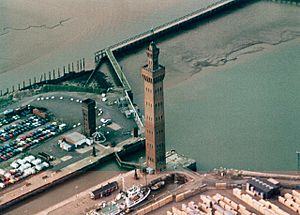Grimsby Dock Tower facts for kids
The Grimsby Dock Tower is a famous landmark in Grimsby, England. It's a special kind of tower called a hydraulic accumulator tower. It was finished on March 27, 1852. Its main job was to hold a huge tank of water, about 200 feet (61 meters) high. This water pressure powered the machines at the Royal Dock, Grimsby. Because it's so tall, you can see the tower from many miles away!
How the Tower Worked
The Grimsby Dock Tower was built to power the machines at the Grimsby Docks. These machines included cranes, lock gates, and sluices. The tower held a large water tank 200 feet (61 meters) above the ground. This height created strong water pressure. Small pumps kept the tank full as the machines used the water.
The tower system started working in 1852. It powered the lock gates, dry-docks, and fifteen cranes. It also supplied fresh water to ships and homes near the dock. The water came from a deep well. This well was fed by other smaller borings that connected to it.
All the engines, pumps, and pipes were made by Mr. Mitchell from the Perran Foundry in Cornwall.
While the Grimsby tower was being built, a new and better system was invented. This new system used heavy weights to create water pressure. It was more powerful and could be built at ground level. The first dock to use this new system was at New Holland, North Lincolnshire. It actually opened before the Grimsby system.
Building and Opening the Tower
The tower was designed by James William Wild. He got his idea from the Torre del Mangia, a famous tower in Siena, Italy. J. M. Rendel oversaw the building of the Royal Dock and the tower.
In October 1854, Queen Victoria and Prince Albert visited the dock. They came to officially open the tower. The ground floor of the tower was decorated with pink, white, and blue fabrics for their visit. Queen Victoria allowed Prince Albert, the Prince of Wales, and the Princess Royal to ride the hydraulic lift. They went up to the gallery near the water tank. From there, they could see Grimsby, Cleethorpes, and the mouth of the River Humber.
The tower is 309 feet (94 meters) tall. It is 28 feet (8.5 meters) wide at the bottom. It gets a bit narrower as it goes up. The walls are 4 feet (1.2 meters) thick at the base and 3 feet (0.9 meters) thick higher up. The bricks for the tower were made from clay found when digging the docks. About one million bricks were used to build it.
There's a local story that the tower was built on cotton wool. This story probably comes from the fact that cotton was imported to West Yorkshire. This trade helped encourage the building of the Royal Dock and the tower.
Later Years and Importance
The Dock Tower provided water for hydraulic power until 1892. Then, a new hydraulic tower was built nearby. This new tower used a 300-tonne weight to create pressure. Today, the dock and lock machines use electric power.
During the Second World War, there were plans to knock down the tower. It was so tall that German planes could use it as a guide to find Liverpool. Later, a special plaque was placed on the tower. It honors the brave crews of the minesweeper ships during the war.
The tower's lift no longer works. To get to the top, you have to use a spiral staircase inside. The second balcony is now used for sending and receiving radio signals.
The Grimsby Dock Tower is a Grade I listed building. This means it is a very important historic building that is protected.
Model
There is a model of the Grimsby Dock Tower made entirely of Lego. You can see it at Legoland in Windsor. The tower model looks correct, but a large building has been wrongly added to its base.



